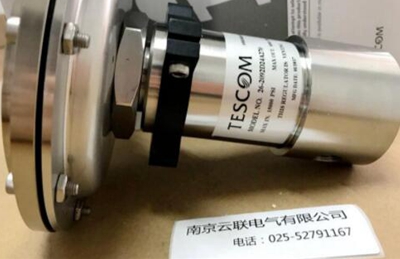
Telephone
025-52791167,52791168
13390905858
13390905858

How to properly repair the TESCOM explosion-proof solenoid valve?
Preventive maintenance is mainly a preventive maintenance measure taken to ensure the reliable operation of the voltage regulator without failure, including the installation and use of explosion-proof solenoid valves on site
A series of preventive measures taken at the time; Fault maintenance of explosion-proof solenoid valves, which refers to a series of actions taken when the regulator fails and cannot meet the usage requirements
Column maintenance is usually completed in the workshop or can be directly carried out in the workshop. Pipeline under special circumstances.
Preventive maintenance refers to planned maintenance prior to control valve failure. It can be understood as daily maintenance, usually including the following tasks.
1.1 Pressure relief pipeline. Various stresses caused by the combination or improper installation of pneumatic control valves, such as the thermal stress caused by high-temperature medium bows, can occur when a fixed single seat control valve is installed
The stress caused by the imbalance of physical strength during the process and the uncertainty caused by human factors. And the pipes caused by these collisions. These stresses will affect the explosion-proof solenoid valve and its pipelines, which
Some stresses can easily affect the regulating valve. In severe cases, it can affect the regulating system itself, causing deformation of the valve stem and guide components, which cannot align with the valve seat
Qi. The split valve body regulating valve may cause the valve body flange to detach; Stress can also cause valve seat leakage. Therefore, it is necessary to ensure that stress can be avoided or eliminated at any time, and that stress
It should be removed from the regulating valve.
1.2 Check the condition of the bearings. The good position for explosion-proof solenoid valves is to position the direction of the valve stem and the actuator on the vertical plane above the valve body. If it is necessary to adjust
The actuator should be supported in the normal working state of the regulator when installed in the position where the valve stem moves horizontally, or when the direction of valve stem movement and the horizontal plane tilt to a certain degree. as
If there is no installation support or installation support, improper installation can lead to improper adjustment of the valve stem and valve seat, which can easily cause differences or lead to packing leakage and other faults. Even if adjusted
The device has fixed support measures and should also be inspected regularly, such as every 2 to 3 months.
Normally closed: When the circuit is energized, the pilot valve core is sucked in, the pilot hole is opened, and the upper chamber of the valve is released. The medium pressure in the lower chamber pushes the piston, and the solenoid valve opens; When the line country loses power
At this time, the pilot valve core is reset by the spring, the pilot hole is closed, the upper chamber of the valve is pressurized by the thrust of the piston hole and the reset spring, and the solenoid valve is closed.
Normally open type: When the line is not energized, the pilot hole closes, and the upper chamber of the valve is pressurized by the thrust of the piston hole and return spring, and the solenoid valve closes. When the power is cut off, the pilot valve core is spring-loaded
Position, pilot hole open, valve upper chamber depressurizes, lower chamber medium pressure pushes piston, solenoid valve opens. Signal feedback: When the valve [] opens, the signal common line is connected to the open signal line:
When the valve is closed, the signal common line is connected to the closing signal line. Selection specifications for signal feedback solenoid valves:
The main control parameters of an electromagnetic valve include diameter, design nominal pressure, allowable temperature range of the medium, interface size, etc.
2. Electromagnetic valves use electromagnets to push the opening and closing of valves, usually used for two position control with diameters ranging from DN15 to DN300, especially for connecting, cutting, or
telephone:025-52791167,52791168
Fax:025-52791169
Phone :13390905858
mailbox:njxj888@163.com
Address:Jiangning Shuanglong Avenue No.1222 Nanjing, Jiangsu. China P.O. 211100